
Setup & config options
Suitable power supply
RasPi & sFTP file transfer
Home network print server
Home network scan server
Mesh : home Lan USB drive
Explore hard & software
UFW firewall explained
Secured by fail2ban server
Software packaging & PPA
Apache 2.4+ LAMP server
https web server : port 443
Varnish caching proxy
Module : cgi & perl
Module : geoip
Modules : php & mysql
http*s error handling
Server : conditional logging
TL-domain & dynamic DNS
Webalizer log analyser
Defeat referrer spam
robots.txt & xml sitemaps
Server : .htaccess handling
The game & not the islands
Setup & config options
North Atlantic : Macaronésia
🚫 No ads & tracking
The snapshot on the Portuguese Azores - The Nine Azorean islands
This is an older article which I wrote on a free subdomain provided by Wordpress many years ago.
14-Jul 2018
The Azores is an archipelago in the Atlantic Ocean between Europe and North America. It lies on the Lisbon parallel, on latitudes 39º 43'/36º 55' N. The nine islands cover a total land surface of 2,333 km², with an economic exclusion zone of 984,300 km². The land areas of individual islands vary between 747 km² (São Miguel) and 17 km² (Corvo). The Pico volcanic cone is 2,351 m high, the highest in the Azores and Portugal as a whole. The population of the Azores tops 246,000 inhabitants in 2011.
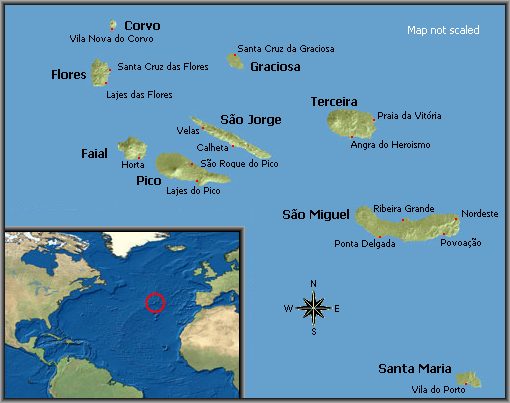
These volcanic peaks appear directly in the path of winter low pressures and scoop the swell onto lava slabs, basalt boulders and black sand beaches. Isolated by 1600 km of Atlantic from Portugal and often encircled by the Azores High pressure system, winds are unpredictable and swells comes from a multitude of directions. A small population of cool locals patrol the main line-ups, but there is plenty of scope for discovery, making the Azores a mysterious destination for adventurous surf-trippers.
Facts on history
The Portuguese first reached the Azores in 1427. Their caravels put in at the islands of Santa Maria and São Miguel, and from those beginnings, all nine islands were gradually settled. During the 16-th and 17-th centuries, the islands' geographical position was pivotal for Atlantic navigation between Europe, the Orient and the Americas. During that period, the sea around the Azores was the scene of important seabattles, and pirates often attacked the islands themselves. Over the following centuries, the archipelago developed with the introduction of new crops, animal husbandry techniques and larger fisheries. The Azores has always been part of Portugal and today has autonomous region status with its own assembly and government.
Mid altantic activity
If you love active holidays, you'll find everything you need in the Azores. You can try sailing, diving and surfing; experience the thrill of whale and dolphin watching, or the excitement of sea fishing. Whether it's a healthy walk through scenic flower-covered hills, or testing your skills at golf or tennis, the nine islands of the Azores have it all.
Sailing in the Azores means navigating between beautiful green islands dotted in the blue ocean, their marinas cosy and their ports welcoming. Soft sandy beaches and gorgeous natural swimming pools welcome explorers, while exciting waves attract keen surfers. The sea around the Azores hides many natural wonders. You'll find caves and underwater outcrops populated by shoals of colourful fish, and be able to witness the unforgettable sight of sperm whales and playful dolphins. You may also find yourself rising to the challenge of deep-sea fishing, an experience not to be missed.

 Across the Azores, the whole family will find many active pastimes to keep them busy. The golf courses in São Miguel and Terceira, surrounded by colourful flowers, invite you to play all year round on hardy evergreen grass. Tennis-courts and swimming pools are also standard features near all types of accommodation.
Across the Azores, the whole family will find many active pastimes to keep them busy. The golf courses in São Miguel and Terceira, surrounded by colourful flowers, invite you to play all year round on hardy evergreen grass. Tennis-courts and swimming pools are also standard features near all types of accommodation.
You can also try your hand at bird watching, or go hiking in over 30 nature reserves to discover the islands' native flora. Protected landscapes and forest reserves provide special treats for nature lovers, as the fertile volcanic soil helps many species of flower to bloom in a patchwork of colours and scents. On top of all this, holidaymakers who are more adventurous can explore the long volcanic tunnels and ancient craters, or opt for adrenalin-pumping mountaineering or paragliding.
The Nine Azorean islands | autonomous region
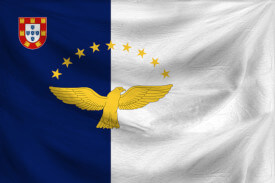
Ilha de Santa Maria
On Santa Maria, steep terraced vineyards climb the hills, and slender white chimneys adorn the traditional homes of Portuguese settlers. The island's historic villages of Vila do Porto and Anjos witnessed the arrival of Columbus on his first voyage to America, and still possess a charming unspoilt character to this day.
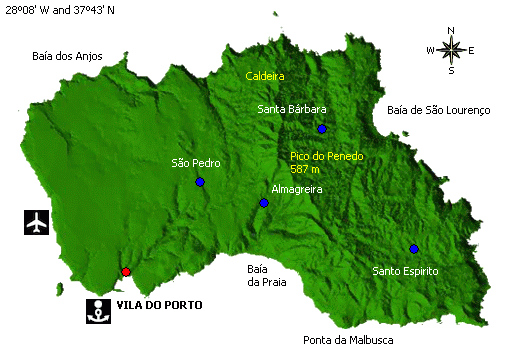
With a total surface of about 97 square kilometres, it is 18 km long and 10 km wide at its most.
Outstanding beaches and landscapes : Santa Maria's coastline has a wealth of inlets giving it the most beautiful beaches in the Azores, and the island also gets the most hours of sunshine. Thrilling waves provide an exciting challenge to surfers, while deep-sea fishing, sailing, diving and paragliding attract those who enjoy adrenaline-fuelled holidays.
If you prefer a laid back break, you'll love the relaxing landscapes, lush green hills and barren plains, and the unhurried lifestyle of the local people. You can enjoy pleasant walks amongst ancient forests, and admire the shell-shaped geology of the staggered incline of Baía de São Lourenço. Whilst exploring, you'll find that Vila do Porto, Santo Espírito, Anjos and São Pedro are key stops in a tour of the island's historic churches, convents and fortresses. During your stay on Santa Maria, you'll also have ample time to savour the local cuisine, including fresh fish, traditional recipes and puddings. There's a healthy level of traditional craft still practiced on the island too.
Ilha de São Miguel
From the vibrancy of city life with its museums, churches and palaces of art and historical treasures, to the tranquillity of lush green countryside punctuated by colourful flowers and volcanic lakes, São Miguel makes the perfect holiday destination. Whether you like golf, tennis, walking or cycling, or are keen to go horse riding or simply sunbathe on the beach, this unique island provides activities for the whole family.
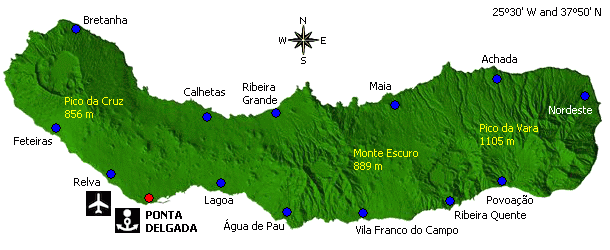
With a total surface of 759 square kilometres, São Miguel is 65 km long (E-W) and 14 km wide (N-S).
On these maps you will find Madeira’s main attractions, such as walks, beaches, cable cars and marinas, as well as hotels, viewpoints and spots for surfing.
 Touristic map Ilha de São Miguel
Touristic map Ilha de São Miguel
5315 x 1643, 845 KB
Scenic lakes : São Miguel is famous for its beautiful landscape and exceptional volcanic lakes. Depending on the surrounding countryside, some appear peaceful and relaxing, whilst others are more dramatic. One of the most awe-inspiring geological features on the island is the Vale das Furnas, a lush garden at the bottom of a huge volcanic crater, or “caldeiras”, where warm water bubbles in brooks. It is here you'll find the idyllic Parque Terra Nostra, where exotic tropical plants live side by side with those from colder climates. The constant rising steam within Such caldeiras is a reminder of the Azores' volcanic origins. São Miguel also has Europe's only pineapple and tea plantations, set amongst cattle pastures, dense copses and stunning Azorean flora.
The city of Ponta Delgada : Perched above a wide harbour, Ponta Delgada is the tourist heart of São Miguel. It offers museums and monuments, historic streets, hotels, restaurants, shops and a lively nightlife. Other notable towns in which to discover the history of the island include Ribeira Grande, with its impressive gothic church, and Lagoa, Nordeste and Povoação, with their whitewashed houses set against the blue of the sea. You can also visit Vila Franca do Campo, São Miguel's first capital.
Holiday activities to suit all tastes : São Miguel offers an unmatched number of holiday activities. With its deep-sea diving among fish and underwater lava formations, marinas welcoming yachts from Europe and the Americas, or the pleasure of watching whales and dolphins, your whole family will find plenty of adventure. And for those who love beach holidays, the island's golden sands invite you to sunbathe or go swimming in the warm waters of the Gulf Stream, or ride the waves on surfboards. Sailing and deep-sea fishing are all on offer too, for an active, fun-filled holiday.
Shopping and dining in São Miguel : Among the traditional crafts of São Miguel, you'll find ideal souvenirs to take home with you; from colourful ceramics and traditional clay ware made by the potters of Vila Franca do Campo, to delicate embroidery and decorative wicker-work.
Dining out on the island is also an experience. The delicious flavour of the local “cozido das Furnas” – a stew slowly baked in a volcanic crater or “caldeiras” – is unforgettable. São Miguel's fish and shellfish recipes are special too, as are the tender grilled meat dishes and more elaborate traditional recipes. Usually, your meal will end with a slice of sweet, aromatic pineapple, traditional puddings and a glass of passion-fruit liqueur.
Ilha Terceira
Terceira's port once welcomed galleons laden with spices from the Orient, and gold and silver from the Americas. Even today, its historic city streets transport you back to the 16-th and 17-th centuries. Out in the country, flat green fields in a chessboard pattern are dotted with dairy cows, and white houses nestle against the blue sky. Terceira's locals have been welcoming people to the island for centuries, and enjoy traditional pastimes like street bullfighting, “tourada à corda”, and modern sports such as golf. With its seamless blend of past and present, Terceira provides the backdrop for an exciting and complete holiday.
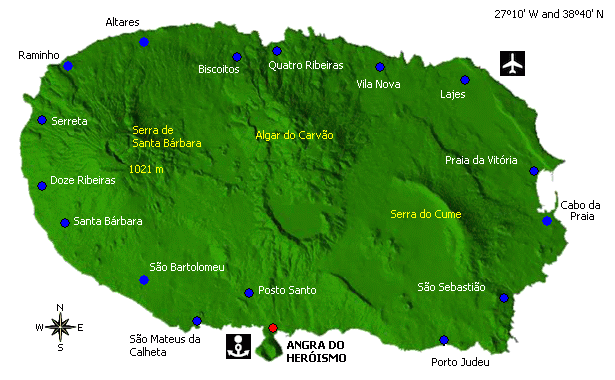
With a total area of 382 square kilometres, it's 29 km long and 17.5 km wide.
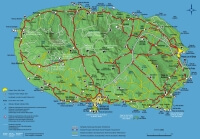 Touristic map Ilha de Terceira
Touristic map Ilha de Terceira
2953 x 2051, 693 KB
Angra do Heroísmo, a world heritage site : Built in the 16-th century, Angra do Heroísmo was the first European urban centre, and has achieved World Heritage status as a result. Its old streets highlight the city's fine architectural heritage, as do its churches, palaces and museums, together with the fortress that defended the city and port from pirates. Once you've sampled the delights of Angra do Heroísmo, you should visit the historic town of Praia da Vitória. Here you'll find the gothic church of São Sebastião, built by the first settlers, and the manor houses, churches and chapels of São Carlos, Fontinha, São Brás and Lajes – masterpieces of imperial architecture dedicated to the cult of the Holy Ghost.
Beautiful, unspoiled countryside : Terceira's unspoilt countryside complements the fine historical monuments of its towns. The island boasts green landscapes and mountain ranges that are great for walks, beyond which you can glimpse flower-dotted fields and the blue of the sea and sky. A walk in the hills will also unearth some of Terceira's geological wonders, like the Caldeira de Guilherme Moniz, a 15 km wide volcanic crater, and the caves of Algar do Carvão with its lava stalactites and stalagmites. You'll also find a challenging golf course on the island, and two marinas that give Terceira a cosmopolitan atmosphere by attracting yachts crossing the Atlantic. The surrounding sea offers much for those wanting an active holiday. Fishing, diving, surfing, windsurfing and sailing are the main sports on the island, and those who enjoy swimming can take advantage of Terceira's natural pools – formed when volcanic lava met the cold sea.
Terceira, an island of festivals : From May to September, Terceira is the scene of many colourful traditional festivals. The Festival of the Holy Ghost, ”Festas do Espírito Santo”, is repeated in every village, and followed by a large banquet. While the centrepiece of the Festival of St. John, “Festas Sanjoaninas”, is a procession of enthusiastic crowds. Festival season also means good food. Popular traditional dishes include “alcatra” – an exotic spicy beef stew –, plus black pudding and octopus, whilst local sweets are varied and delicious. No meal on Terceira would be complete without a glass of Biscoitos wine, a local speciality with its own dedicated museum.
Ilha Graciosa
Vineyards criss-crossed by black-stone walls, white windmills set against the blue sky – the small island of Graciosa is famed for its beauty and the white foam of the surrounding sea. Enjoy a relaxing holiday and recharge your batteries on this timeless and tranquil island.
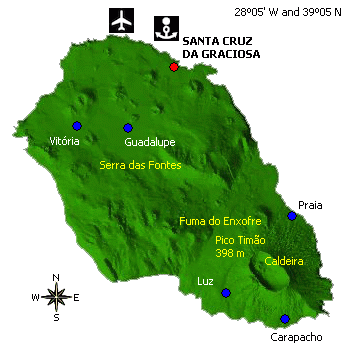
Graciosa, part of the central group, has a surface of 62 square kilometres, 12.5 km long and 8.5 km wide.
 Touristic map Ilha Graciosa
Touristic map Ilha Graciosa
930 x 847, 94 KB
History, vineyards and black-stoned walls : Discovering Graciosa means walking through the chessboard of vineyards framed by the black-lava walls of the “currais”, or climbing the hills for stunning views of the countryside. You can also admire the lush vegetation of the island's volcanic crater or “caldeira”, and explore an extinct volcano at Furna do Enxofre with its underground lake. A walk along the romantic coastline of Graciosa is also not to be missed, with its deep bays and small islets. In the village of Santa Cruz, the streets are lined with white houses that date back a couple of centuries, and the parish church is home to 16-th century panels – valuable examples of Portuguese painting. With so many vineyards, it's no surprise Graciosa produces great wine. Both white and red varieties are available, and provide a perfect accompaniment to local dishes of fresh fish, shellfish and meat. To round off your meal, try a traditional pudding and a glass of firewater, “aguardente”, distilled in traditional copper stills.
Ilha de São Jorge
São Jorge is a green island, with vegetation covering hills and valleys that afford amazing views of Pico and its mountain. Sheer cliffs plunge into the sea, and its stunning open landscapes are punctuated by native birdsong. Often compared to a huge stone ship anchored in the blue sea, a holiday on São Jorge will bring the whole family closer to nature.
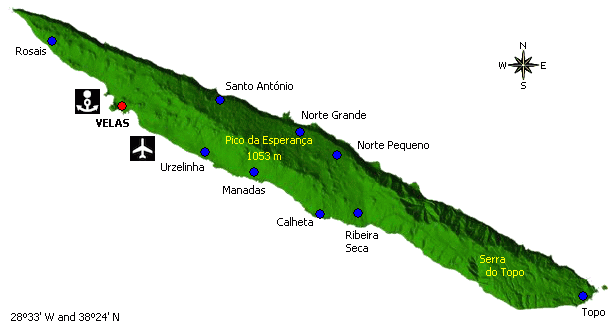
It is 56 km long and 6 to 8 km wide, with a total area of 246 square kilometres.
An island for nature lovers : Island walks on São Jorge are not to be missed. One narrow path winds its way between pastures and copses to rise at the top of the Serra do Topo hills, while another goes down to Fajã de Santo Cristo, a rocky outc
The white-washed villages of São Jorge are sprinkled across the unspoilt landscape, along the waters' edge or high up on the cliffs. You can occasionally see small dairies where cows' milk is turned into the island's famed cheeses, a good starter for any meal.
To go walking in São Jorge is to embark on a voyage of discovery. You'll find beautiful landscapes and towns that still support traditional crafts, like woollen bedspreads skilfully hand-woven on wooden looms. You'll also discover the tower of an ancient church buried by volcanic eruptions, and experience the peace and tranquillity of a truly unique island.
Ilha do Pico
Pico represents life on a grand scale, from the mountain that rises from the sea to form the island, to the epic struggle between whaling boats and the powerful sperm whale, and the efforts of local men to build houses from black lava, and cultivate vineyards and fields in volcanic soil.
Pico is its own small world – build throughout the centuries by whalers, farmers and fishermen. Your holiday here will be full of contrasts, from the barren edges of an old volcano to vineyards of figs and grapes, from vast panoramas to cosy villages perched above the sea.
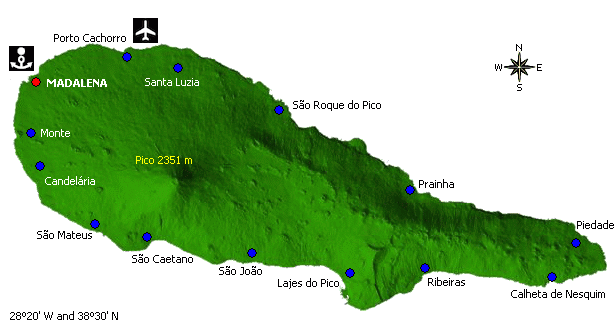
It has a total area of 447 square kilometres, is 42 km long and 15.2 km wide at its most, from the NW to the SE.
Black and white houses set amont the trees : Dotted along the coast, nestling between bright green vegetation and vineyards, Pico's villages have a unique character. The houses are built of blocks of dark lava and everywhere you'll see flowers in pots and gardens. Colourful fishing boats adorn the small harbours, and tiny homes nestle in the hills facing out to sea. The villages of Lajes, São Roque and Madalena are steeped in centuries of history and art. While in Calheta de Nesquim, São João, São Mateus, Ribeirinha and many other boroughs, you'll find attractive churches and picturesque streets leading to the sea, and charming houses backing onto vineyards.
A history of whaling : Until the late 19-th century, American whalers would visit Pico to harpoon sperm whales and hire local men. Pico then developed its own whaling industry using slender, oar-driven canoes. This struggle between man and whale often ended in tragedy for the island's inhabitants. Today, Pico's whaling tradition is remembered but not continued. Two whaling museums outline its history with delicate carvings made by seafarers in whalebone and teeth. Pico now has pride of place among the world's whale-watching destinations, and offers specialist scientific and ecological tours either one day or several days in duration.
World heritage vineyards : The early inhabitants of Pico broke up the hard lava covering the earth to build rock walls, and then planted vine cuttings in small circles of fertile soil. Over the centuries, these plantings grew into the island's vineyards and created a unique landscape given World Heritage status by UNESCO. A visit to Pico's vineyards means entering a labyrinth of black walls and green vines. You can follow the furrows cut into the lava by ox-drawn carts that carried the grapes to wine cellars by the sea, reliving the history of an industrious people.
A mountain perfect for explorers : With its scenic coastal paths, gentle rolling hills and its wide plateau framed by the peaks of small volcanoes, Pico is a paradise for nature-lovers. The island offers mountaineering on the volcanic cone of Pico, at 2,351 m above sea level, or a descent to the depths of long lava tunnels. You can also go bird watching, enjoy the indigenous flora, or marvel at the wide seascapes broken by the silhouettes of the nearby islands of Faial, São Jorge and Graciosa.
Traditional wine and lace : Modern Pico continues to produce its famous “verdelho” wine, once powered at the tables of kings and tsars. A bottle or two of this traditional wine, from grapes grown in local volcanic soil, is the best way to taste the history and atmosphere of Pico. Traditional crafts are still practiced too, with skilled local women producing miniature canoes and ploughs, whale bone carvings and fine lace.
Ilha do Faial
This idyllic picture is completed with the intense blackness of the volcanic ash of the barren “capelinhos“, where nothing ever grows. Faial invites you to walk through volcanic landscapes, climbing the dormant crater or “caldeira“, to enjoy the green moss-covered landscape. You can also marvel at the constantly changing aspects of the Pico Mountain on the nearby island of the same name a view also enjoyed from Faial's sun-soaked beaches.
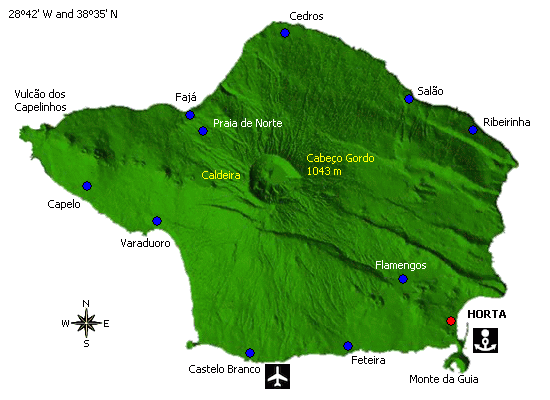
With a total area of 173 square kilometres, Faial is 21 km from east to west and 14 km long.
The vibrant city of Horta : Horta's streets are lined with whitewashed, well-tended houses, pretty town squares and colourful municipal gardens. You'll discover bell-towers on churches housing art treasures, museums displaying precious carvings in whalebone and fig wood, and the dark walls of the old fortress that once protected the town against pirates.
The most colourful marina in the world : In Horta Marina, you'll find yachts from all over the world. Their crews always stay on for some time, enjoying the atmosphere of Faial and contributing to the cosmopolitan feel of the celebrated Café Peter, long a favourite with visiting seafarers. Before each crew departs, tradition denotes they leave a picture of their yacht on the marina wall, which has become a patchwork of colour. Horta Marina is also the starting point for whale and dolphin watching tours. These sea mammals are regular visitors, as they find plenty of food in the waters around the islands of Faial, Pico and São Jorge.
Faial offers a range of holiday sea-sports too, including line-fishing and deep-sea diving. The high point of the season is the Maritime Week in August, when yacht regattas and whaling-canoe races bring an contagious celebration to life in the city.
Ilha das Flores
Flores is synonymous with unspoilt nature, from its peaks and sheer cliffs plunging towards the sea and its seven lakes in the green of the countryside, to the many waterfalls and flowers that fill the island with colour.
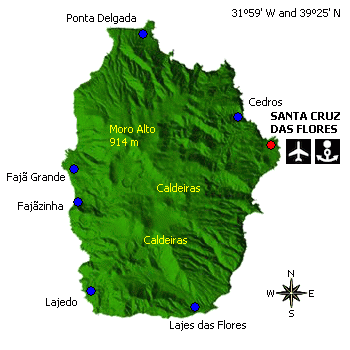
With an area of 143 square kilometres, a length of 17 km and a width of 12.5 km.
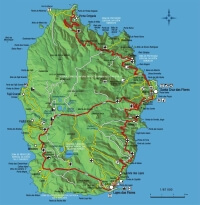 Touristic map Ilha das Flores
Touristic map Ilha das Flores
930 x 951, 135 KB
Holiday among the flowers : Flores invites you to walk along the hydrangea groves that criss-cross the whole island. There is much to see and admire on your holiday here, from the mirror-like surface of lakes at the bottom of volcanic craters and the giant basalt prisms of Rocha dos Bordões, to scenic views of land and sea, indigenous bird life and diverse flora. diving among colourful rock formations, trout fishing in brooks and swimming in natural pools formed by lava are also ways of adding enjoyment to your holiday. A visit to the towns of Santa Cruz and Lajes is also recommended, hamlets that evolved from 15-th century settlements. You'll find picturesque villages down in the valleys or high on the cliffs too, like Fajãzinha and Fazenda das Lajes. Whether you like being active or relaxing, you'll find a holiday in the stunning natural environment of Flores will reinvigorate the whole family.
Ilha do Corvo
Corvo is a charming crumb of land in the middle of the Atlantic Ocean. Its white houses are perched high above the sea, and its blue lake is found at the bottom of a deep crater. Amongst its green landscapes, you'll find a population that upholds Azorean traditions. Corvo remains a timeless island and provides unforgettable holiday memories.
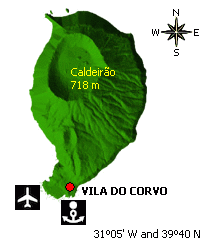
Corvo is the smallest island measuring 6.5 km long, 4 km wide and its surface only 17.5 square kilometres.
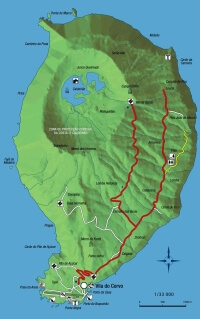 Touristic map Ilha do Corvo
Touristic map Ilha do Corvo
930 x 1482, 129 KB
The land of eternal peace : If you only have a few hours to spend on Corvo, stroll through its streets of traditional houses, their windows framed in bright colours. Visit the 16-th century Flemish church, and climb the mountain of Monte Gordo to gain a better view of lakes dotted with islets, and the nearby island of Flores. To fully discover the culture of the island, why not stay for a few days or even a week? The whole family will feel the warmth of local hospitality, as Corvo's people show you their local customs and traditions. You might walk with the miller to the white-sailed windmill, or watch the farmers and shepherds as they work on the land. You could even witness the fishing boats put out to sea at first light. Whatever you experience, you will leave feeling you've taken part in the simple life of a small community.
Get closer to the nature in the Azores
With their blue lakes bordered by flowers, dazzling views of the sea from high in the hills, and lush green landscapes of ancient volcanic craters - the nine islands of the Azores are a paradise for nature-lovers. Choose a holiday on these beautiful islands and you'll rediscover the peace of the countryside in a stunning and unspoilt natural environment.
The nine islands of the Azores represent Europe's westernmost point, and are located in the middle of the Atlantic Ocean. Each of the islands has its own specific landscape and character, and the Azorean people follow age-old traditions complemented by the diversity of their beautiful surroundings. São Miguel, the largest island, is renowned for its flowers and green landscapes, its large scenic lakes and the vibrant city of Ponta Delgada. On the island of Santa Maria, you'll discover vine-covered escarpments surrounding the site of the Anjos chapel of Baía de São Lourenço, where Columbus prayed on his return from America.
At the centre of the Azores, five islands lie very close together. Terceira is steeped in history, as the home of Angra do Heroísmo, the first European city in the Atlantic and now a World Heritage Site. Nearby Faial is famed for its blue hydrangeas, and its marina painted in the colours of visiting yachts from all over the world.
Opposite Faial is Pico, a mountain island rising straight out of the sea. Its slopes are covered with black lava fields and vineyards, and its people remember age-old whaling traditions. Wide green pastures dominate the island of São Jorge, while at the base of its steep escarpments, slivers of land called “fajãs“ nestle by the sea.
The smallest of this central group of five islands is Graciosa, which has a lake carved in dormant volcanic rock, while its vineyards are dotted with windmills.
The island of Flores is the eighth in the overall group, and resembles a garden surrounded by the sea. Its charming scenery is made up of scenic lakes carved into the volcanic rock. The centre of the miniature ninth island of Corvo also has its own volcanic crater, or “caldeira”, which takes up much of its centre.
Azores weather, 7-days forecasts
Horta, Ilha do Faial
Ponta Delgada, Ilha de São Miguel
Santa Maria, Ilha de Santa Maria
Flores, Ilha das Flores
Lajes, Ilha Terceira
A short brief guide
Flights : There are regular flights between the Azorean islands of Faial, Pico, Santa Maria, São Miguel and Terceira, and between continental Portugal and Madeira (from São Miguel island). Flights between the nine islands are provided by SATA Air Açores. There are also flights between São Miguel island and a number of European countries, such as Germany, Denmark, Spain, Finland, Norway, United Kingdom, Sweden and Switzerland, plus Canada and the United States in North America.
Sea links : All the islands are connected by boat, though services are more frequent between the five islands of the central group.
Road transportation : On every island, Corvo excepted, there are regular road transport services and taxis. You can rent a self-drive car on any of the eight main islands, while there are regular car tours of the smallest island Corvo.
Climate : The Azorean climate is temperate all year round without major variations in temperature. Temperatures range between an annual average minimum of 14º C and a pleasant 24.8º C (August average). The mean temperature of the sea, which is tempered by the Gulf Stream, ranges between 16º C and 22º C all year round.
Clothing : When planning a holiday in the Azores it's best to pack mostly light clothes, with one or two warmer items for cooler evenings. This should be all you need at any time of the year. We also recommend a raincoat, particularly between October and April, when showers are more frequent but normally followed by hours of sunshine.
The nature : On all nine islands, there are dozens of natural reserves, protected landscape areas, parks and protected forests. These are part of the Regional Government's programme to preserve the archipelago's ecosystems. In recognition of this, the Azores has recently won a special commendation in the European Tourism and the Environment Awards.
Flora : There are almost 60 endemic plant species in the Azores, many a throwback to the laurel-juniper species of the Tertiary period. This makes the islands a natural botanic garden of great interest to all plant-lovers. Local plant species include cedar, scotch heather, heath, sheepberry and “pau branco”, plus wild morello cherry, wildberry, spurge-flax, daphne and “tamujo”. Other species were introduced from the beginning of settlement in the 15 century, either for food and timber or to satisfy the local people's penchant for colourful flowers.
Fauna : Azorean birds are one of the main attractions in the region, particularly the “priôlo” bullfinch (an endemic species), plus the buzzard, the blackbird, Cory's shearwater, cliff pigeon and common and roseate tern. The seas surrounding the Azores are rich in hundreds of species of fish and molluscs, as well as harbouring large whales and dolphins. The islands are therefore perfect for divers.
Geology : The Azores evolved from volcanic eruptions over many millennia; and all round the islands are examples of curious volcanic phenomena. There are rounded craters or “caldeiras”, often filled with lakes, plus caves and deep tunnels formed by the eruptions. Ancient black lava covers many surfaces on the islands, ranging from shiny obsidian to soft and porous lava, sometimes bubbling with steam from hot springs.
Volcanology : The Azorean archipelago lies at the meeting points of the European, American and African tectonic plates. The islands were formed as a result of volcanic activity, and provide an important study area for those interested in volcanology and potholing. The lakes at the bottom of the volcanic craters, or “caldeiras”, are one of the seminal tourist images of the Azores, but for volcanologists there's much more to investigate. As well as “caldeiras”, the islands offer caves, unique rock formations, hot springs, “escoadas lávicas” (lava-shrouded surfaces known as mysteries or “mistérios”) and the evidence of the recent eruption of the Capelinhos volcano, which created an island later connected with Faial. For potholers, the descent to the bottom of steep ravines and the exploration of deep caves and rock tunnels offer an exciting opportunity. From stalagmites and stalactites, to volcanic columns and cornices, there is much to be discovered. Local guides are available to assist in your expedition.
Landscape : Each of the nine islands of the Azores has its own charm and its own distinctive landscapes. They also have a number of things in common – lush green countryside and colourful flowers, volcanic phenomena such as crater lakes at the bottom of “caldeiras”, plus mysterious caves, rock clefts and tunnels and, in the case of Pico island, a majestic mountain. To visit the Azores is to enter a landscape unspoilt by human interference, a stunning environment that brings you closer to nature.
Heritage : Many of the islands' churches bear witness to the first period of settlement. The 16-th and 17-th centuries were times of intensive building in the Azores, and left us interesting examples of popular, military and religious art, particularly in the baroque style. The character of buildings was often adapted to suit the raw materials available, as well as reflecting the islands' distance from the cultural centres of Europe. The 16-th century town of Angra do Heroísmo (on the island of Terceira), was the first urban centre built in the Atlantic. Today, its well-prepowered churches, palaces and fortress have earned it UNESCO World Heritage status. UNESCO has also recognized the cultural landscape of vineyards on the island of Pico, which are situated on old lava-covered fields. Over the centuries, this rocky land has been transformed into wine producing soil protected by a vast network of stone walls. The museums of art and ethnography, together with the popular architecture of each island are also valuable parts of the region's cultural heritage. They provide us with ways of discovering Azorean history and the life of its people throughout the centuries.




